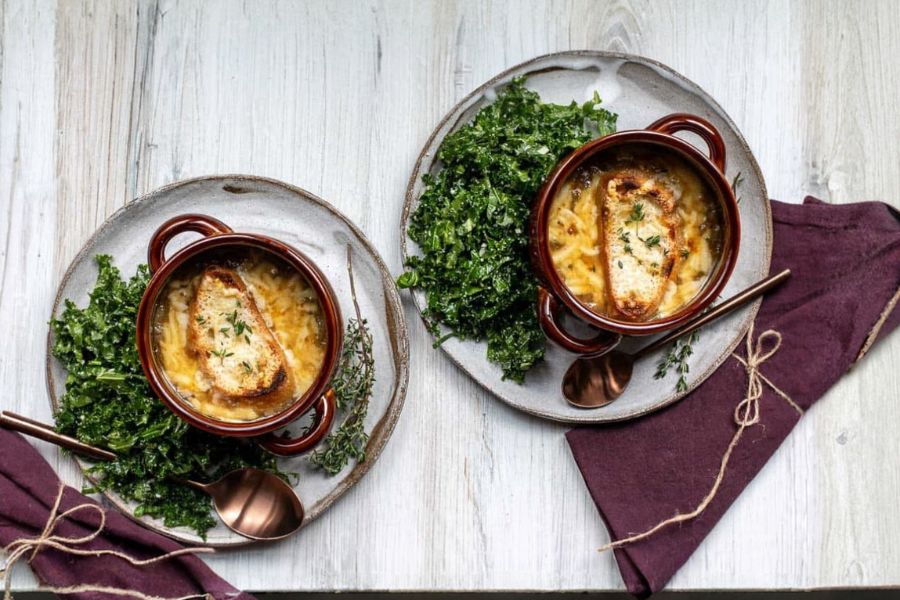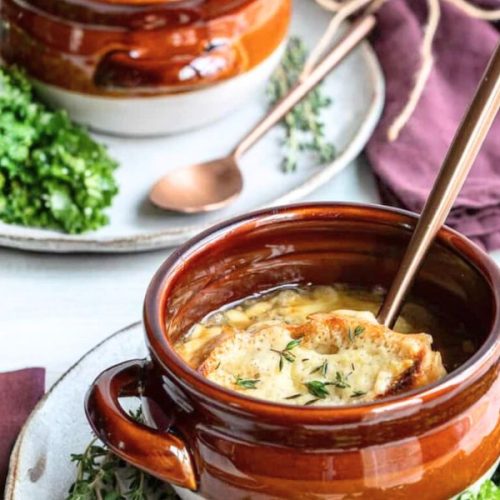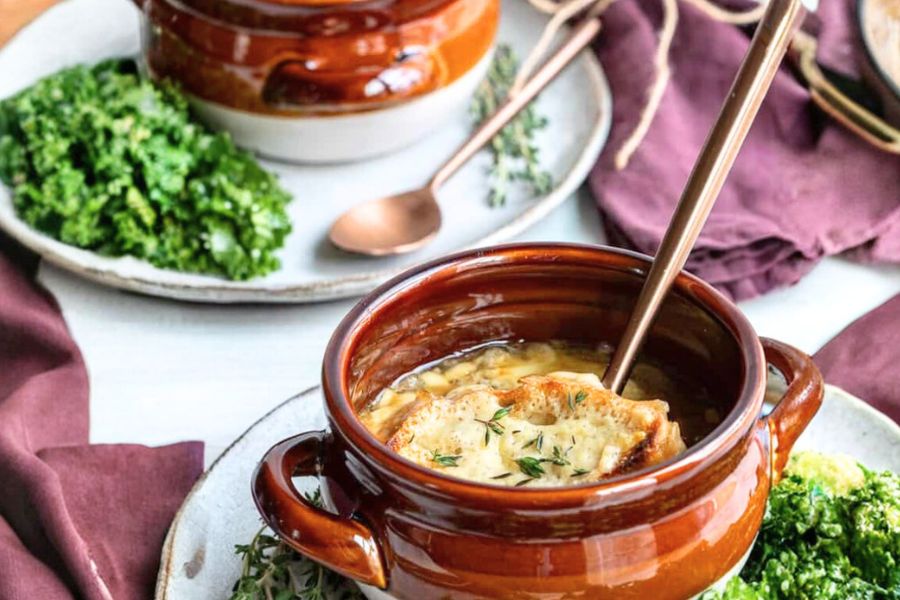This classic French Onion Soup recipe stands out for its rich, deeply caramelized onions that create a savory, comforting base, perfectly balanced by the bright acidity of white wine and the hearty depth of beef stock.
What makes this recipe especially appealing is its high protein content from beef stock and Gruyère cheese, alongside fiber from the onions and bread, delivering a satisfying and nutritious meal.
While it’s indulgent with good fats from butter and cheese, the recipe balances flavor and nourishment, making it ideal for those seeking comfort food without compromising on nutrition.
The long, slow caramelization process unlocks intense flavor, making this soup perfect for cozy dinners.

Plus, its straightforward steps and forgiving nature make it approachable for everyday cooking, whether for a family meal or an elegant solo treat.
Must-Have Tools for Perfect Results
Rimmed Baking Sheet
Useful for transporting multiple soup crocks safely and catching any spills, this baking sheet also doubles as a roasting pan or a surface for cooling baked goods.
Broiler-Safe Soup Crocks
Essential for oven-to-table serving, these crocks safely withstand high broiler heat to melt and brown cheese perfectly. Beyond this recipe, they add a rustic charm to soups and gratins, making your presentation shine.
Large Saucepan
A heavy-bottomed saucepan ensures even, slow caramelization of onions without scorching. This versatile pot is a kitchen staple, perfect for soups, sauces, and more.
Kitchen Torch
Ideal for browning cheese when a broiler isn’t available, a kitchen torch offers precise control and a beautiful golden finish. It’s also perfect for caramelizing desserts or adding flair to any dish.

Nutritious Classic French Onion Soup
Equipment
- 1 Large Saucepan
- 4 Broiler-Safe Soup Crocks
- Kitchen Torch (optional)
- 1 Rimmed Baking Sheet
Ingredients
- 5 large yellow onions about 3½ pounds, peeled and thinly sliced
- 2 garlic cloves finely minced
- 4 tablespoons unsalted butter
- 1 tablespoon olive oil
- ½ teaspoon Worcestershire sauce
- ¼ cup dry white wine
- 5 cups beef broth preferably rich and flavorful
- 2 sprigs fresh thyme plus extra for garnish
- 1 bay leaf
- ½ teaspoon kosher salt
- ¼ teaspoon freshly ground black pepper
- 4 thick slices of baguette or sourdough bread toasted lightly
- 1¼ cups shredded Gruyère cheese about 3¾ ounces
Instructions
- Prepare the Aromatics: Start by peeling and slicing the onions as thinly as possible to ensure even cooking. Mince the garlic cloves finely to release their flavor during cooking.
- Begin Caramelizing Onions: In a large heavy-bottomed saucepan, melt the butter together with the olive oil over medium-low heat. Add the sliced onions and minced garlic along with a pinch of salt to help draw out moisture. Cook slowly, stirring occasionally, for about 30 minutes. The onions will start to soften and turn translucent.
- Deepen the Flavor: After 30 minutes, stir in the Worcestershire sauce. Continue cooking the onions gently, stirring more frequently now, scraping up any browned bits stuck to the bottom of the pan. This slow process should take about 30-40 more minutes until the onions become soft, richly browned, and fully caramelized. Be careful not to burn them—if the pan gets too dry, add a splash of water to loosen the browned bits.
- Deglaze and Build the Broth: Pour in the white wine and cook for a few minutes until the liquid has mostly evaporated, which will concentrate the flavors. Then add the beef broth, fresh thyme sprigs, and bay leaf. Season with salt and black pepper.
- Simmer the Soup: Bring the mixture to a gentle boil over medium-high heat. Reduce the heat slightly and let it simmer uncovered for 15 minutes to allow the flavors to meld beautifully.
- Final Seasoning and Remove Herbs: Discard the thyme sprigs and bay leaf. Taste the soup and adjust salt and pepper according to your preference.
- Assemble and Broil: Divide the hot soup evenly among four broiler-safe bowls. Place one slice of toasted bread on top of each portion. Sprinkle the shredded Gruyère generously over the bread and soup.
- Melt the Cheese: Place the bowls under a preheated broiler for about 3 to 4 minutes, or until the cheese is melted, bubbling, and lightly browned. If you don’t have a broiler-safe dish, use a kitchen torch to melt and brown the cheese carefully.
- Garnish and Serve: Finish by sprinkling fresh thyme leaves over each bowl and serve immediately for a warm, comforting meal
Notes
- The key to a flavorful French Onion Soup lies in slowly caramelizing the onions over low heat to coax out their natural sweetness without burning. This step takes time but is worth every minute.
- If your onions begin to stick or dry out during cooking, add a small amount of water to deglaze the pan and keep the onions moist.
- For a thicker broth, whisk in 1 to 2 tablespoons of flour after the wine has reduced but before adding the beef broth.
- Using broiler-safe soup crocks makes it easy to finish the dish in the oven and serve straight to the table. If unavailable, a kitchen torch or toaster oven can help melt and brown the cheese on separate toast slices.
- Placing the soup bowls on a rimmed baking sheet helps transport them safely to the broiler and catches any bubbling spills.
Chef’s Secrets for Flavorful Soup
Achieving the deep, rich flavor that defines an excellent French Onion Soup hinges on patience and technique.
The secret lies in slowly caramelizing the onions over low to medium-low heat, allowing their natural sugars to develop fully without burning.
Stirring frequently towards the end of this process prevents scorching and encourages even browning.
Using a quality beef broth enhances the soup’s savory backbone, while a splash of dry white wine adds brightness and complexity.
When melting the Gruyère cheese, broiling it until bubbly and slightly golden creates that irresistible texture and aroma. If you don’t have broiler-safe bowls, a kitchen torch can replicate this effect with precision.
Lastly, fresh thyme adds a subtle herbal note that ties all the flavors together, so don’t skip this fresh garnish.
Serving Suggestions to Impress Guests
French Onion Soup pairs wonderfully with a variety of side dishes that complement its savory richness.
A crisp green salad dressed lightly with vinaigrette provides a refreshing contrast to the hearty soup.
Roasted vegetables like asparagus or Brussels sprouts add an earthy balance, while a crusty baguette or garlic bread on the side can extend the meal’s comforting vibe.
For a beverage, a glass of dry white wine or a light-bodied red such as Pinot Noir enhances the flavors without overpowering them.
Serving the soup in broiler-safe crocks directly to the table adds an elegant touch, perfect for dinner parties or cozy family meals.
Storage Tips for Leftovers and Prep
French Onion Soup stores well, making it an excellent make-ahead meal. Refrigerate leftovers in an airtight container for up to 3-4 days.
When reheating, warm the soup gently on the stovetop to preserve the delicate caramelized onion flavor—avoid boiling, which can flatten the taste.
If you plan to store before broiling, keep the soup, bread, and cheese separate to maintain texture.
Assemble and melt the cheese only just before serving to prevent soggy bread.
For longer storage, the soup base freezes beautifully for up to 2 months; thaw overnight in the fridge and reheat slowly.
Frequently Asked Questions Answered
1. Can I make this soup vegetarian?
Yes! Substitute the beef broth with a rich vegetable broth and skip the Worcestershire sauce or use a vegetarian version. The caramelized onions still provide a deep, flavorful base.
2. What’s the best cheese alternative?
Gruyère is traditional for its meltability and nutty flavor, but Emmental or Swiss cheese work well as substitutes. Avoid cheeses that don’t melt smoothly.
3. How do I prevent burnt onions?
Cook onions slowly over medium-low heat and stir often, especially as they start to brown. Add a splash of water if they stick or begin to dry out.
4. Can I prepare this soup ahead of time?
Absolutely! Caramelize the onions and prepare the soup base a day ahead. Store separately from bread and cheese, then assemble and broil just before serving.
5. Is there a gluten-free option?
Yes, simply replace the bread with gluten-free toast or omit it entirely. The soup itself is naturally gluten-free aside from the bread.
This recipe has been adapted and simplified from the original version by vanillabeancuisine. We’ve refined the steps for a smoother cooking experience and added helpful notes, nutrition insights, and essential kitchen tools to make it even easier for home cooks.

